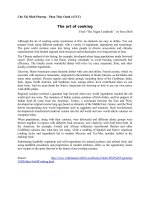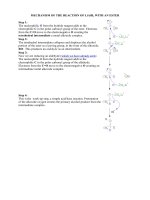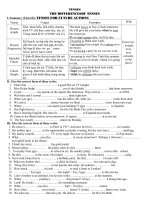the riddle of the sphinx
Bạn đang xem bản rút gọn của tài liệu. Xem và tải ngay bản đầy đủ của tài liệu tại đây (26.71 KB, 2 trang )
The Riddle of the Sphinx The study of myths probably began in the
4th century. BC. when Euthemerus explainedthem as exaggerated
adventures of historical individuals. The allegorical interpretation ofmyths
, stemming from the 18th century study , says that at one time myths
were invented by wise men to point out a truth, but after a time myths
were taken literally. The linguisticcorruption interpretation says that myths
could be understood as allegory for events found innature. The Jungians
school denoted myths as a mechanism of wish fulfillment. Sir
JamesFrazer, believed that all myths were originally connected with the
idea of fertility in nature,with birth, death, and resurrection of vegetation
as a constantly recurring motif. Though themodern interpretation of myths
is not general but a specific explanation for myths of a singlepeople. The
theological interpretation states that myths are foreshadowings of facts of
theScripture or corruptions of them. This view, which is not
contemporarily popular, issurprisingly enlightening when attention is paid
to the meaning of names of characters andplaces in relation to Biblical
stories. Even recent fairy tales which fall into the category ofmyth, often
reveal through metaphor more truth in scripture than one would
anticipate. The most relevant and necessary topic for the
understanding of the imagery andsymbolism of myth is found in the
framework of the celestial zodiac. The pictures foundtoday in the zodiac
were not developed by the Greeks, but were in place perhaps as early
as4000 B.C. predating even the civilizations of Sumaria. The pictures
were not arranged inhaphazard order to aid in the tracking of the star
movements but with order and purpose ofdepicting an epic narrative. This
understanding of the zodiac reveals an intelligence andscientific
understanding that was corrupted through time . The symbolism which
remains canbe analyzed to reveal the basic truth behind it. The
story of the sphinx is an excellent example of the zodiac / myth
connection. Thesphinx a composite creature with the head of a woman or
man and the body of a lion wasassociated with the guarding of sacred
sites of antiquity. It represented the whole of thenarrative of the zodiac,
with the head of a woman, Virgo the beginning of the celestial cycleand
the body of a lion, Leo,the end of the cycle. In fact, the actual design for
what scripturecalls a cherub is in actuality,a sphinx. The angels were
beings whose sole purpose was toreflect the will and the glory of the God
who created them. They were depicted symbolicallyas composite
creatures whose parts reflected the zodiacal narrative. The Greek
mythOedipus Rex contains symbols of relevance to corrupted truth.
When Oedipus encounteredthe Greek sphinx, he was asked a riddle.,
"What speaks with one voice, yet in the morningwalks on four legs, walks
at noon on two legs and in the evening walks on three legs?" Oedipus
was the only man to answer correctly. The answer was "man". Upon
hearing herriddle solved the sphinx screamed in rage, threw herself to the
rocks below her lofty perchand died. Such a simple answer to this
enigmatic question leaves one to ponder its significance.Whatmore can
be gleaned from the content of the story? The sphinx as it has been
stated wasactually a symbolic depiction of an angel. This angel was not,
however, anything like thedutiful messengers of God described in
scripture but a horrible monster bent on the destruction ofany man it
came in contact with. The biblical basis for such a creature is found in
Ezekial 28.The "king of Tyre" or "King of the rock" as he is symbolically
addressed, was the greatest ofall angels. In fact so great was his
splendor that he believed himself as great as his creator.









